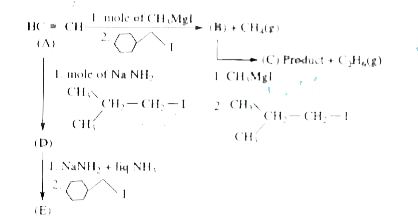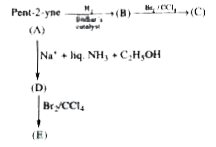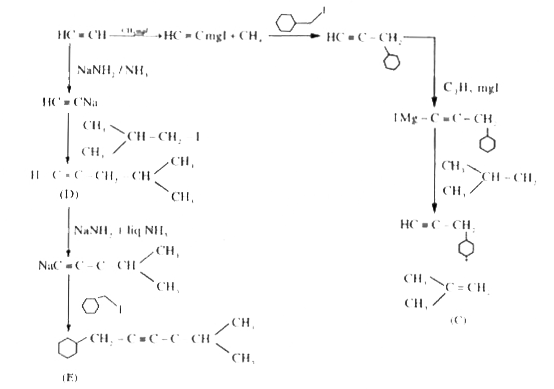
Produce (C) is Solution in Telugu



Both (b) & (c)
The correct Answer is:D
Topper's Solved these Questions
- BOOK - AAKASH SERIESCHAPTER - HYDROCARBONSEXERCISE - ADDITIONAL PRACTICE SHEET ( LEVEL-II (LECTURE SHEET (ADVANCED) (LINKED COMPREHENSION TYPE QUESTIONS(PASSAGE-V))))3videos
HYDROCARBONS
- BOOK - AAKASH SERIESCHAPTER - HYDROCARBONSEXERCISE - ADDITIONAL PRACTICE SHEET ( LEVEL-II (LECTURE SHEET (ADVANCED) (LINKED COMPREHENSION TYPE QUESTIONS(PASSAGE-VI))))3videos
HYDROCARBONS
- BOOK - AAKASH SERIESCHAPTER - HYDROCARBONSEXERCISE - ADDITIONAL PRACTICE SHEET ( LEVEL-II (LECTURE SHEET (ADVANCED) (LINKED COMPREHENSION TYPE QUESTIONS(PASSAGE-III))))3videos
HYDROCARBONS
- BOOK - AAKASH SERIESCHAPTER - GENERAL ORGANIC CHEMISTRYEXERCISE - QUESTIONS FOR DESCRIPTIVE ANSWERS35videos
GENERAL ORGANIC CHEMISTRY
- BOOK - AAKASH SERIESCHAPTER - HYDROGEN AND ITS COMPOUNDSEXERCISE - QUESTIONS FOR DESCRIPTIVE ANSWERS20videos
HYDROGEN AND ITS COMPOUNDS
Similar Questions
The nitro group is a very strong deactivating group Nitro benzene undergoes nitration at a rate only 10-4 times that of benzene. The nitro group is a meta-directing group. When nitrobenzene is nitrated with nitration mixture 93% of meta substituted product is formed.
When benzene is nitrated then Nitrobenzene is obtained and when nitro benzene is nitrated then the product which is 7% of the yield is_______04:24View SolutionPyridine like benzene, has six π -electrons in delocalized π -orbitals, but unlike benzene the orbitals will be deformed as electrons are more attracted towards the nitrogen atom because of its high electro negativity. This is reflected in the dipole of pyridine which has the negative end on N and the positive end on the nucleus. We can compare the respective properties of benzene, pyridine, pyrrole, furan and thiophene, which very frequently give aromatic electrophilic and nucleophilic substitution reactions in different positions.
Arrange the following in increasing order of aromatic character.
 01:18View Solution
01:18View Solution
Compounds (B) and (D) are, respectively02:57View SolutionMention the hybridisation stste of each carbon in the following compounds.
CH3−CH=C=O,CH3−C≡C−CH3,CH3COCH3andCH2=CHCN01:46View SolutionWhy the use of hard water is disadvantages?
View SolutionABCD is a parallelogram. AD is a produced to E so that DE=DC and EC produced meets AB produced in F. Prove that BF=BC.
View Solution._(6)^(11) C on decay produces:
01:35View SolutionHigh C/N ratio produces
04:50View SolutionThe ozonolysis of gt C= C lt produces
03:30View SolutionHeterolysis of C-Br bond produces
05:44View SolutionThe treatment of CH3MgX with CH3−C≡C−−H produces :
01:07View Solutionc-DNA का निर्माण किया जाता है-
01:12View SolutionA तथा B दो स्वरिन्न 4 विस्पन्द/सेकण्ड उत्पन्न करते हैं। तो B तथा C स्वरिन्न 5 विस्पन्द/सेकण्ड उत्पन्न करते हैं, तो A तथा C स्वरिन्न ..... विस्पन्द/सेकण्ड उत्पन्न कर सकते हैं।
04:47View SolutionABCD is a parallelogram. AD is a produced to E so that DE=DC and EC produced meets AB produced in F. Prove that BF=BC.
00:48View SolutionABCD is a parallelogram. AD is a produced to E so that DE=DC and EC produced meets AB produced in F. Prove that BF=BC.
01:46View Solution


